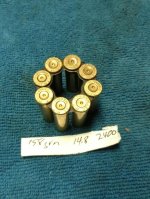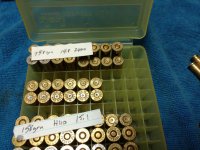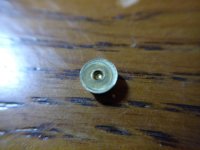I've seen flat primers, but the ones in the moon clip seem to be flater. Same batch as the top row in my box.
Nosler .357, 158 grain JHP, p/n 44841
Top row and moon clip loaded with 2400 @ 14.8 grains.
Model two rows are factory Blazer Brass 158 JHP and PMC 158 JLT for comparison.
Bottom rows are the same bullet with H110 @ 15.1 grains.
Has anyone else noted anything like this before? Should I be concerned? I double checked and these are starting loads. I crimped at the cannelure. OAL is 1.580. Good roll crimp.
Firearm is a 327 TRR8
Nosler .357, 158 grain JHP, p/n 44841
Top row and moon clip loaded with 2400 @ 14.8 grains.
Model two rows are factory Blazer Brass 158 JHP and PMC 158 JLT for comparison.
Bottom rows are the same bullet with H110 @ 15.1 grains.
Has anyone else noted anything like this before? Should I be concerned? I double checked and these are starting loads. I crimped at the cannelure. OAL is 1.580. Good roll crimp.
Firearm is a 327 TRR8
Attachments
Last edited:




